Malcolm Le Grice: Before and After Cinema

Berlin Horse, by Malcolm Le Grice
Los Angeles Filmforum and REDCAT present
Malcolm Le Grice: Before and After Cinema
Monday February 11, 2019, 8:30 pm
At REDCAT, 631 W 2nd St, Los Angeles, CA 90012
Malcolm Le Grice in person!
REDCAT, in collaboration with Los Angeles Filmforum, welcomes UK legend Malcolm Le Grice for his first California screening in decades. One of the most compellingly original and radical artist-theorists in the history of the post-war moving image, Le Grice has been innovating at the center and the fringes of time-based media for over fifty years, embracing and exploring the signification of images, multiple projection, and the materiality of media. Le Grice’s body of work functions as an illuminating and rigorous investigation of the fundamental form, essence, and politics of cinema, and this program will span and celebrate the breadth and richness of his singular career. Malcolm Le Grice’s visit made possible by a generous grant from the Mike Kelley Foundation for the Arts. Additional screenings at USC on Feb 14 and at Filmforum at the Egyptian on Sunday Feb 17.
"An entire alternative, parallel history of cinema can be constructed through the work of artist and experimental filmmaker Malcolm Le Grice.” – BFI
“The diverse and influential career of Malcolm Le Grice makes him one of the most eminent avant-garde filmmakers working today. The critical importance of his films is the degree to which the representational image is undermined by foregrounding other material aspects of the medium, spanning the surface texture of the projected image to the live experience of watching a film. To paraphrase an idea in one of Le Grice’s own essays, ‘Real Time/Space’ (1972), the ‘projection event’ takes precedence over represented content - an overhaul of cinema’s default mode.” – Simon Payne, Sight and Sound
Tickets: $12 general; $9 for students/seniors, REDCAT and Filmforum members; $6 for Cal Arts students with ID. Available in advance from Ovation tix at https://web.ovationtix.com/trs/pe.c/10361113 or at the door.
Malcolm Le Grice studied painting at the Slade School of Fine Art but began to make film, video and computer works in the mid 1960s. He has shown in major international venues including at the Museum of Modern Art, New York, the Louvre Museum and Tate Modern. His films and videos are in collections at the Centre Georges Pompidou, the Royal Belgian Film Archive, the National Film Library of Australia, the German Cinematheque Archive and the Archives du Film Experimental d'Avignon. A number of longer films have been broadcast on British TV, including Finnegans Chin (1981), Sketches for a Sensual Philosophy (1986-89) and Chronos Fragmented (1995).
Le Grice has written critical and theoretical work including a history of experimental cinema, Abstract Film and Beyond (London and Cambridge: Studio Vista and MIT, 1977.
For three years in the 1970s he wrote a regular column for the art monthly Studio International and has published numerous other articles on film, video and digital media. Many of these have been collected as an anthology under the title Experimental Cinema in the Digital Age by the British Film Institute (London: 2001). Le Grice is a Professor Emeritus of the University of the Arts London where he is a collaborating director with David Curtis of the British Artists Film and Video Study Collection. Les Presses du réel recently published an extensive book on his works: Le Temps des images, edited by Yann Beauvais (Paris: 2015). https://www.malcolmlegrice.com/
Curated by Steve Anker, Bérénice Reynaud and Mark Toscano as part of the Jack H. Skirball Series. Funded in part by the Ostrovsky Family Fund, with the support of the Mike Kelley Foundation for the Arts.
REDCAT | THE ROY AND EDNA DISNEY/CALARTS THEATER
is located at 631 West 2nd Street, Los Angeles, CA 90012 - at the corner of 2nd and Hope Streets inside the Walt Disney Concert Hall complex. Parking is available in the Walt Disney Concert Hall parking structure and at adjacent lots. Unless otherwise specified, tickets are $12 for the general public, $9 for members. Tickets may be purchased by calling 213.237.2800 or at www.redcat.org or in person at the REDCAT Box Office on the corner of 2nd and Hope Streets (30 minutes free parking with validation). Box Office Hours: Tue-Sat | noon-6 pm and two hours prior to curtain.
----------------------
Los Angeles Filmforum screenings are supported by the Academy of Motion Picture Arts and Sciences, the Los Angeles County Board of Supervisors through the Los Angeles County Arts Commission and the Department of Cultural Affairs, City of Los Angeles. We also depend on our members, ticket buyers, and individual donors.
Los Angeles Filmforum is the city’s longest-running organization dedicated to weekly screenings of experimental film, documentaries, video art, and experimental animation. 2019 is our 44th year.
For more information: https://www.redcat.org/event/malcolm-le-grice-and-after-cinema, www.lafilmforum.org or 323-377-7238.
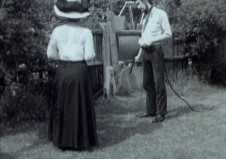
After Lumière - l'arroseur arrosé
After Lumière - l'arroseur arrosé
1974, 13.5 minutes
The film recounts the simple practical joke played by a little boy on the gardener. The boy stands on the water hose, the gardener looks down the nozzle to find the obstruction, the boy steps off the hose and the gardener is soaked. My remake adds a number of new features - there is a third character, the woman of the house - is she also the lover? The boy is now a girl dressed as a boy and the whole sequence of events is repeated four times.
It explores all four versions of film material – black and white positive, black and white negative and color positive and negative – as well as sound and different viewpoints and camera movements. It places the spectator into the role of cinema detective, asking the philosophical question of what can you know for sure from the evidence of the cinematic document.
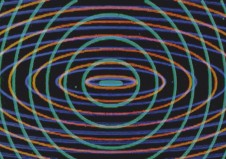
Your Lips 3
Your Lips 3
1971, 3 minutes
A re-worked version of Your Lips 1 with multiple colour superimpositions. Originally shown with a sound track from computer artist Alan Sutcliffe but replaced by a re-mixed track of one of the prepared piano pieces made by Le Grice in 1964/5.
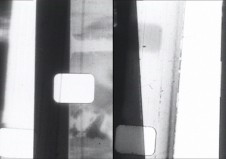
Little Dog For Roger
Little Dog For Roger
1967, 9 minutes
Well – I thought it was about film as a medium and material – scratches, sprocket holes, dirt, slippage in the projector, blank screen, gaps in the sound-track – I forgot that one of the boys was me, the other was my brother, the young woman was my mother – now dead – and behind the camera was my father – now dead – see the cyclops – the dog was mine – nothing to do with Roger – that is another story.
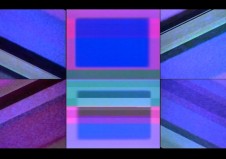
Joseph’s Newer Coat
Joseph’s Newer Coat
1998, 16 minutes
Music – Ben Le Grice – produced in very close collaboration with Stewart Louis de Cannonville (Low 948)
Abstract color fields - stripes and chevrons - a club or disco piece - sheer visual and musical physicality - nothing more but also nothing less. Joseph’s Newer Coat is entirely made from video color fields recopied, re-videoed and superimposed. It explores interference rhythms produced by a strobing rewind of tape, the full screen and screen within screen within screen. It is entirely abstract and continues
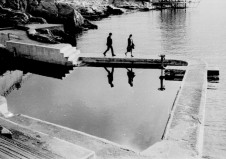
Wharf
Wharf
1968, 8 minutes
Originally the work was presented as a pre-ordered sequence of 35mm slides showing two unknown people walking around the wall of a sea-side swimming pool. Switching between positive and negative focus on the mystery of the hidden and unresolved narrative between the ‘lovers?’. On occasions, this work was shown in superimposition with sections of the film Talla. Two sound tapes were mixed in improvisation.
A digital video version has been made using the original slide sequence and audio tapes.
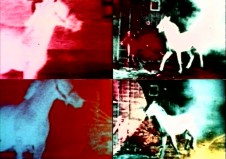
Berlin Horse
Berlin Horse
1970, two-screen version matted side by side on a single 16x9 format, 9 min.
Music by Brian Eno.
Berlin Horse combines two sequences. The first one, showing a horse being exercised, was originally shot in 8mm in the village of Berlin near Hamburg in northern Germany. It was then re-filmed in 16mm from the screen, running the film at different speeds and directions and with the camera at different angles. Later it was re-colored using theatrical lighting gelatins in the film-printer and subject to multiple superimposition, and was finally combined with the second sequence – The Burning Stable, a newsreel of horses being led from a burning barn, made by the Edison manufacturing company in 1896. Both sequences were visually treated and transformed at the London Film Makers Cooperative. The film is a poetic drama where the sequence of image transformations and the 'narrative' are integrated as the content.
“The experience of watching Berlin Horse rests on an appreciation of its almost pure plastic elements: color, movement, rhythm and segments of time. These elements are only ‘almost pure’ because they are activated by the film’s imagery… The lunging of the horse is reflected in the film’s looping structure. The added color dramatizes the burning stable scene, and calls to mind the misregistration and ‘fringing’ endemic in certain experimental color processes during the early part of the 20th century. The motif of the horse in motion also places the film in a lineage that includes Eadweard Muybridge’s proto- cinematic studies of animal locomotion. But for all this, the use of imagery is not directed towards drama, documentary or even reflexivity as such. The aesthetic of the film is a distinct and unique alternative to given modes and conventions of filmmaking.” – Sight and Sound
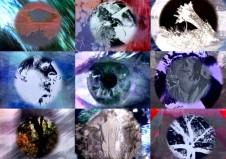
Even a Cyclops Pays the Ferryman
Even a Cyclops Pays the Ferryman
1998, three screen video, 17 min.
Music by Le Grice including re-mix of music commissioned from John Eacott for Chronos Fragmented (1995).
An allegory for the passage from being alive to being dead. The cyclops is the one-eyed father - the one-eyed king in the land of the blind - the single lens of the camera - three screens beyond stereoscopy.
It is a form of requiem made on the death of my father. It is not religious, but mythological. It is materialist – about decay and the rebirth of new chemical combinations – the continuation of the life of others after the death of one – the decaying and transforming memories and images – floating by as the brain is no longer constrained by the urgency of presence. Whose memories – those of the artist? – those of the represented subject? – metaphors for the viewer's memories? – and is the video image a memory?
Digital Aberration
2004, 3 minutes
Every cheap visual effect in the editing package and a sound track made with free software from a corn-flakes packet.
